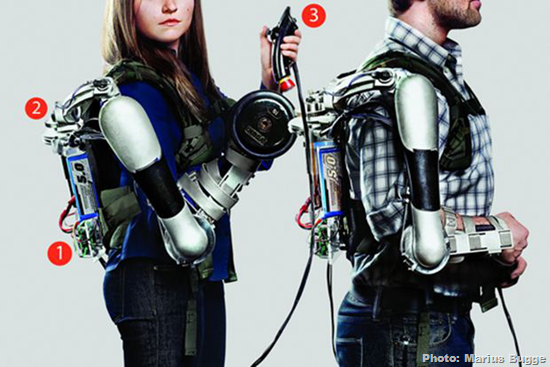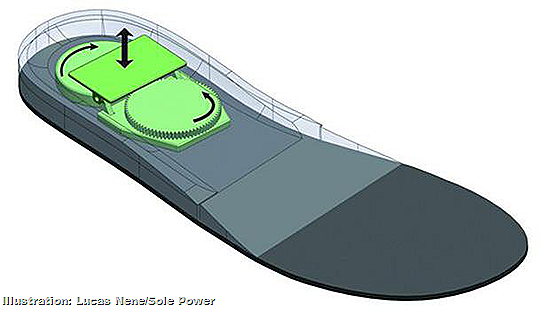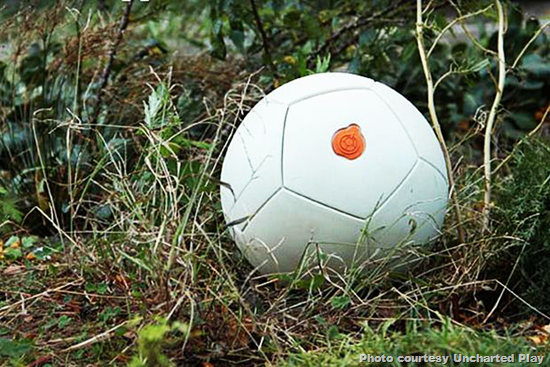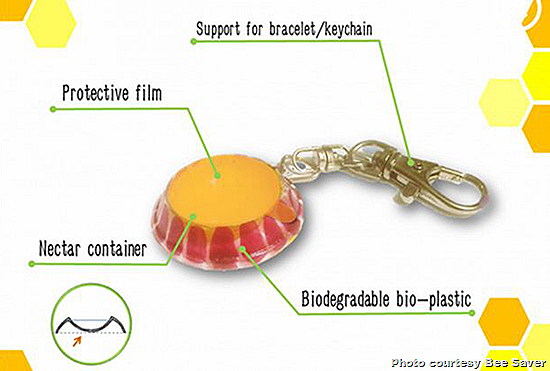
From an edible water blob to a first aid kit for bees, these innovations help make the world a better place.
1. Edible Blob
Industrial design students Rodrigo García González, Guillaume Couche, and Pierre Paslier from Spain designed the Ooho, an alternative to the plastic bottle. They used a process called “spherification” to make a thin membrane out of brown algae and calcium chloride to hold water. The result? An edible water blob that costs 2 cents to make. The project is still in development, but the team licensed it under Creative Commons so everyone can experiment and make Oohos at home.
2. Titan Arm
Robotic exoskeletons, designed to support injured or paralyzed patients, on average cost more than a car and have to be plugged into a wall. So mechanical engineering students at the University of Pennsylvania came up with a cheaper, stronger, more efficient option: the Titan Arm. Elizabeth Beattie, Nicholas McGill, Nick Parrotta, and Nikolay Vladimirov designed the US$2,000 prototype over two semesters in 2012 and have received positive feedback from injured athletes and stroke victims. “We’ve been looking at 3-D printing to fully customize the components, like tailoring a suit,” Parrotta told Popular Science.
3. SolePower
Backpacker and engineering student Matt Stanton wanted a more efficient alternative to heavy power packs and solar chargers that depend on the weather. So he looked to his shoes. With the help of another Carnegie Mellon University engineering student, Hahna Alexander, he created SolePower, a removable insole that fully charges an iPhone with a 15-mile walk. His team’s improving the design before its expected launch later this year so that it can power a smartphone when the user walks fewer than five miles.
4. Energy-Generating Soccer Ball
Kick this soccer ball around for 30 minutes, and you’ve got three hours’ worth of electricity that can charge a cell phone and small appliances. The Soccket Energy Ball, which comes with an LED lamp, was designed by Harvard students Jessica O. Matthews and Julia Silverman with countries that rely on toxic kerosene lamps in mind. Each ball can be pre-ordered for US$99, and the items are expected to ship this fall.
5. Portable Cellular Network
Growing up in the mountains of Alaska, UC Berkeley researcher Kurtis Heimeri knew the inconveniences of living somewhere remote. So he created the Village Base Station, a small grey box that brings cellular coverage to areas not covered by major networks. The box launched last year in a village in Indonesia, where the nearest city is a four-hour drive away. According to the Technology Review, it covered 350 subscribers.
6. Cavity-Fighting Gum
Billions suffer from tooth decay because dental care isn’t affordable in many parts of the world. Five University of Pennsylvania undergraduates came up with a tasty solution: Sweet Bites. The FDA-approved chewing gum contains xylitol, a natural sugar substitute that can reverse and prevent tooth decay. The gum launched in July in Bangalore, India, and is now being produced locally.
7. First Aid Kit for Bees
Bees are dying, so one aerospace engineering student from the University of Padua in Italy is doing his part to save them: by creating the Bee Saver. Hady Ghassabian worked with beekeepers to create the small keychain containing artificial nectar. The gadget is designed to be placed near an exhausted or fallen bee, which can take a sip for energy to fly back to its hive. Ghassabian has a working prototype and promises to make the Bee Saver available soon.
8. Solar-Powered Cooker
Barbecues and firewood aren’t that sustainable, so Milan, Italy-based industrial design student Bodin Hon came up with Solari, a portable, pollution-free solar cooker. The gadget uses lenses to trap heat, which is then used to warm liquids such as soup. As of this summer, Hon has been refining the design and testing out recipes.
9. Pacific Garbage Patch Cleaner
Boyan Slat was only in high school when he proposed a machine with movable arms that could collect plastic trash in the ocean. Now, with support from the government and a report detailing the feasibility of the project, the Dutch teenager has raised more than US$2 million to make it a reality. Slat said that it could help remove half of the Great Pacific Garbage Patch in a decade.
10. Wearable Technology for Alzheimer’s Patients
It’s a simple but genius idea: wearable sensors that beam mobile alerts when an Alzheimer’s patient strays from bed. In 2014, Scientific American bestowed a Science in Action Award on 15-year-old New Yorker Kenneth Shinozuka, giving him US$50,000 to develop the sensors, which can be worn on the feet. His grandfather, who suffers from dementia, inspired him. "I will never forget how deeply moved my entire family was when they first witnessed my sensor detecting Grandfather's wandering," said Shinozuka in a statement. "At that moment, I was struck by the power of technology to change lives."










No comments:
Post a Comment
Please adhere to proper blog etiquette when posting your comments. This blog owner will exercise his absolution discretion in allowing or rejecting any comments that are deemed seditious, defamatory, libelous, racist, vulgar, insulting, and other remarks that exhibit similar characteristics. If you insist on using anonymous comments, please write your name or other IDs at the end of your message.